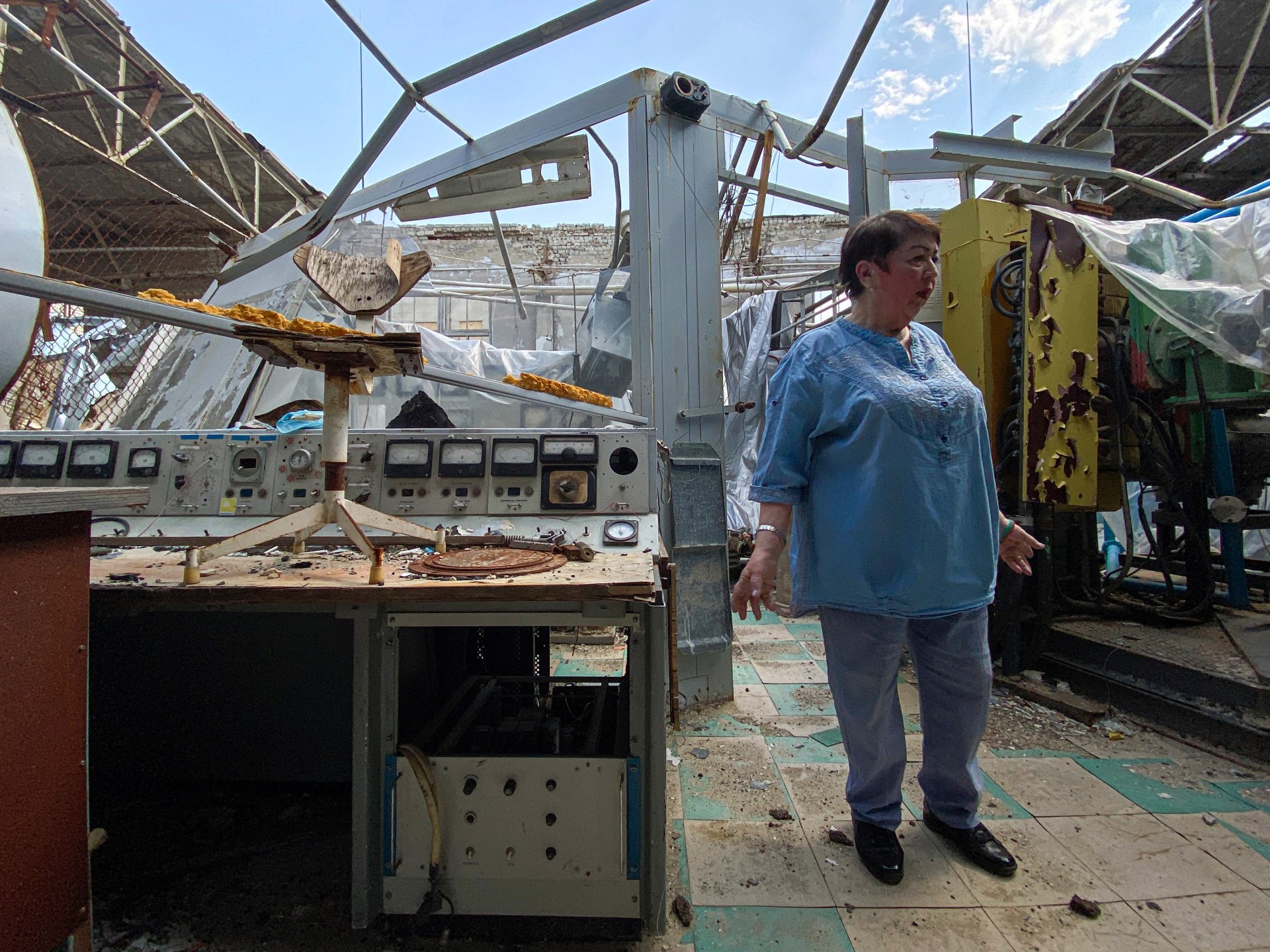Ukraine exploits Biden’s cluster bomb gamble in fight against Russia
The artillery crew first received U.S.-made cluster munitions a few weeks ago following President Biden’s decision to send the weapon in the most controversial arms transfer of his presidency. The bombs are outlawed in more than 120 countries under a 2008 international treaty, but not in the United States, Russia and Ukraine.
Human Rights Watch called Biden’s decision “profoundly troubling.” Germany, France, Canada, the Netherlands and several other NATO allies publicly opposed the move, citing the potential for civilian casualties. Forty-nine House Democrats, alongside 98 Republicans, voted in favor of a defense bill amendment that would have sought to block the transfer.
But the deployment of the weapon has caused little hesitation inside Ukraine’s government and military, which provided The Washington Post rare access to the equipment and soldiers using the notoriously imprecise munitions. Military officials, however, would not allow the cluster bombs to be photographed.
“It’s a positive thing. It helps us to significantly increase Russian losses in equipment and in lives,” Mykhailo Podolyak, a top adviser to Ukrainian President Volodymyr Zelensky, said in an interview.
Cluster bombs explode in the air over a target, releasing dozens to hundreds of bomblets across an area as wide as several football fields. The bomblets then explode into metal fragments that can tear off limbs and inflict fatal injuries. Children are particularly vulnerable, because the submunitions can fail to explode until they are picked up, even years after a conflict has ended.
To reassure the public, Ukraine’s defense minister said U.S. cluster munitions “will be used to break through the enemy defense lines” — a reference to the maze of Russian trenches and minefields that have slowed Ukraine’s counteroffensive. But in practice, soldiers said, the utility of cluster munitions is more complicated.
The munitions cannot penetrate Russian troops hiding in foxholes, but they are a menace to exposed infantrymen advancing on Ukrainian territory, soldiers said.
“The main benefit is that the enemy is now very scared to go on assault,” said Stanislav, who, like other soldiers, spoke on the condition that only his first name or call sign be used because of security concerns in discussing sensitive military matters.
Russian units advancing with armored vehicles and unmounted infantry halt their forward movement to allow troops to seek cover from the ricocheting shrapnel, soldiers said. “They even recognize the cluster bombs by the whistle they make when headed their way,” said Stanislav, a member of Ukraine’s 14th Mechanized Brigade.
The capability is particularly important in light of Russia’s offensive push near the towns of Lyman in the eastern region of Donetsk and Kupyansk in the Kharkiv region to the north. The Kremlin is forcing Ukraine to defend those cities at a time when Kyiv needs soldiers focused on its counteroffensive in the south. Having a weapon that slows the Russian advance allows Ukraine to preserve force strength.
Stanislav’s crew fires cluster munitions from a hulking M109 Paladin nestled under the cover of severed pine branches and tall trees. The U.S.-made self-propelled howitzer can fire a cluster munition a distance of more than 15 miles and can adjust the width of bomblet spray across several football fields or a narrower range depending on the operator’s preference, Stanislav said. The crew is also armed with cluster munitions that scatter mines on the ground.
In the south and east, near Ukrainian cities like Vuhledar, Ukrainian artillery crews also use U.S. cluster munitions, firing them from Paladins or M777 howitzers, military officials said.
When it comes to offensive operations, Ukraine uses the munitions to fire into dense forests when the precise location of Russian forces is unknown, to hit unarmored vehicles, and to spray bomblets over infantry to keep them burrowed in foxholes and unable to return fire.
Members of the artillery crew in northeastern Ukraine described an incident in late July in which they fired upon a Russian convoy of three vehicles — two armored and one unarmored — after spotting them with a surveillance drone. The U.S. cluster munitions bounced harmlessly off the armored vehicles but immediately pierced the unprotected one, causing “panic” and a retreat of the vehicles in “different directions,” one soldier said.
Ukrainian soldiers said cluster munitions also allow their advancing forces to get closer to fortified Russian positions because enemy infantry stay burrowed in their bunkers. “They don’t stick their heads out when cluster fire is happening,” another soldier said.
Another tactic is to flush out Russian infantry from their foxholes using more powerful artillery and then switching to cluster munitions once they have surfaced. “It just depends on the objective,” a Ukrainian soldier said.
While the cluster bombs bring a qualitative military benefit, they also provide quantitative advantage at a time when Ukraine needs more ammunition to extend the scope of the counteroffensive. The start of the latest campaign in early June saw a dramatic increase in Ukrainian artillery fire, to 8,000 rounds per day from approximately 3,000 to 5,000, military analysts said.
Without the influx of cluster munitions from the United States and other artillery from South Korea, Kyiv probably would be unable to sustain its counteroffensive long enough to retake significant territory.
“Ukraine is firing more ammunition than normal,” said Rob Lee, a military analyst with the Foreign Policy Research Institute. “A big question is how long can they do that before they run low on ammunition and have to scale back operations.”
Military analysts have questioned the wisdom of using cluster munitions in areas where Ukrainian soldiers plan to maneuver given the threat unexploded ordnance poses to their troops. But in interviews, soldiers and government officials shrugged off the threat, arguing that troops already have to tiptoe through a gantlet of mines and tripwires. Unexploded submunitions add only a marginal risk, they said.
“Cleaning up unexploded ordnance is going to require a huge effort — not because of U.S. cluster munitions but because of the incredible amount of mines planted by the enemy,” Andriy Besedin, the head of the Kupyansk city military administration, said in an interview.
The Biden administration, which is committing $91.5 million in demining assistance to Ukraine, views the problem similarly. “Regardless of whether Ukraine fires these munitions, these areas will require significant remediation post-conflict, and we will provide assistance to support future Ukrainian demining efforts,” said a senior U.S. official, who spoke on the condition of anonymity to discuss a sensitive military matter.
U.S. production of cluster bombs ended in 2016 amid outrage over Saudi Arabia’s use of U.S.-made CBU-105 munitions in multiple civilian areas in Yemen. The controversy spurred the Obama administration to place a hold on transfers of the munitions to the kingdom, a decision that cut into the industry’s profits and resulted in the last U.S. manufacturer of cluster bombs, Textron Systems, to halt production in August of that year, citing “regulatory challenges.”
The cluster munitions the Biden administration is sending to Ukraine are much older, and pose an even greater threat to civilians. The bomb is called the dual-purpose improved conventional munition, or DPICM, and production of it ended in the 1990s. The longer the munition stays in storage, the higher the “dud rate” — the share of bomblets that remain unexploded after a cluster bomb is fired. Biden’s decision to send the munitions — a choice he described as “difficult” — bypassed a U.S. law prohibiting the transfer of cluster munitions with a dud rate of more than 1 percent.
In welcoming the U.S. decision to send the munitions, Ukraine’s Defense Ministry said Kyiv will keep a “strict record of the use of these weapons and the local zones where they will be used.” But when asked about how the documentation process works, Stanislav suggested that there was none. A public affairs officer later contradicted him, saying that every time the M109 shoots a round, the crew writes down what type of munition was fired and in what direction.
The Biden administration says Ukraine provided the United States with assurances that it will closely track the use of the munitions. Since the delivery of the cluster bombs last month, a senior U.S. official said that Washington is satisfied with Kyiv’s follow-through, which includes “regular updates on the Ukrainian military’s DPICM expenditures and use, including location of use.”
Many details surrounding the U.S. supply of the cluster bombs, however, remains unknown to the public, prompting human rights groups to call for greater transparency. “We haven’t been told the quantity of cluster munitions being transferred and for how long this will be done,” said Mary Wareham, an arms specialist at Human Rights Watch. “We also don’t know the dud rates of these particular munitions.”
Wareham and other advocates worry that the U.S. decision to transfer the munitions undermines efforts to establish an international norm banning the controversial weapon.
Evidence that Ukraine used its own supply of cluster munitions to liberate the city of Izyum in 2022, causing civilian casualties among Ukrainians, has also been cited by critics of Biden’s decision to transfer the weapon. (Ukraine denies using the munitions to recapture Izyum.)
Ukrainians are highly aware of the threat posed by cluster munitions. Russian forces have used the weapon extensively since the war began and at least 24 times in populated areas in Ukraine, according to the United Nations. An attack on a busy train station in Kramatorsk in April 2022 killed 50 Ukrainians and injured more than 100, according to Human Rights Watch.
Russian President Vladimir Putin threatened to step up use of the cluster munitions following Biden’s decision to send the weapons. “If they are used against us, we reserve the right to mirror actions,” he told a pro-Kremlin journalist last month.
Since his comments, there have been several reports of Russian cluster bomb attacks across Ukraine, including an assault on a Ukrainian training ground near Druzhkivka that killed one soldier and injured a team of journalists from the German news outlet Deutsche Welle. “I thought I was going to die,” said Kyrylo, a local employee of Deutsche Welle, whose leg was pierced by shrapnel in the attack. “You just start hearing explosions everywhere.”
That same week, a Russian journalist for the state-controlled RIA news agency was killed and three other Russian journalists were injured in a Ukrainian artillery attack in the Zaporizhzhia region that Moscow said involved U.S. cluster munitions. Ukraine denied the allegation.
Injuries from a cluster munition attack are gruesome. The exploding shrapnel can cause multiple blast or fragment wounds, damaging internal organs and often resulting in the loss of eyes, hands and feet.
“The wounds are very bloody,” said Alina Mykhailova, the head of a medical unit operating near Kupyansk. “The shrapnel pieces are very small and there are a lot of them. If it hits you in the throat, you probably won’t survive.”
Despite the grisly nature of the weapon, Mykhailova, whose fiancé died in combat near Bakhmut earlier this year, said Ukraine had every right to use it against invading Russian forces — a common refrain in this battle-hardened country.
“It’s probably not humane,” she said, “but it’s still the most effective.”
Check out our Latest News and Follow us at Facebook
Original Source







